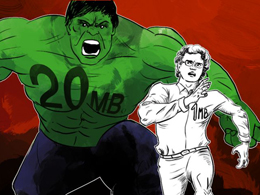
China's Bitcoin Miners See Profit in a Bigger-Block Blockchain
It was not entirely an idle joke when one speaker at China's first miner conference quipped that if the audience decided to launch a 51% attack against the bitcoin network, they would probably be able to pull it off. Over a foggy weekend, around 250 people (the majority being miners gathered in Chengdu) filled a rather spacious conference hall to its capacity for an event called China's Miners' Conference, a mostly promotional event organized by major miner Bitmain. But, they came for more than the province's famous spicy food. As of late, Sichuan has acquired the reputation of being the....
Related News
What’s wrong with increasing the block size limit? This is the question that a portion of the Bitcoin community has been asking almost nonstop since the controversy around this possible alteration to the protocol went into hyperdrive last year. In a recent appearance at Bitcoin Meetup Switzerland, Bitcoin Core Contributor Jonas Schnelli covered at least one possible issue with raising the block size limit too quickly: the effect larger blocks have on wasted resources for miners. It should be noted that Schnelli has decided not to take an official, public stance on the block size debate. A....
The top (left) and bottom (right) of the Block Erupter USB. Bitcoin mining has evolved rapidly over the past few years. From CPUs, to GPUs, to FPGAs, to ASICs, the most up-to-date and powerful miners change constantly. When the first ASIC miners were shipped to customers in early 2013, miners became incredibly more powerful than before. Among the first ASIC miners announced was the Block Erupter USB: a small USB (Universal Serial Bus) that mines for Bitcoins. A History. Block Erupter USBs were first announced by friedcat on May 4th, 2013, on BitcoinTalk.org. They were small, portable, yet....
As this debate on BitcoinTalk demonstrates, the current rhubarb regarding increasing the block size limit in Bitcoin has been ongoing since at least 2013 in a public manner... as well as a heated one. The discussion between the Bitcoin core developers goes on for 26 pages. The most recent post is April 2013. It starts with Peter Todd, who still to this day opposes increasing the block size limit in the manner being proposed via Bitcoin-XT. I fear very few people understand the perverse incentives miners have with regard to blocks large enough that not all of the network can process them,....
The world’s two largest economies; two of the three most populated countries on earth; much more importantly: the world’s two largest Bitcoin mining communities locking horns in a struggle for power and control over the Bitcoin blockchain. The Far East versus the West; the United States versus China: a classic battle of global superpowers that may not have a winner, but may take the world’s first global currency down in the digital crossfire. The issue of Bitcoin block size is coming to a head within a matter of days. Could a battle over block size between Western businesses and Eastern....
The need to increase the blockchain limit has been an ongoing debate these days, as the current size limits the network's capacity to verify transactions. At the moment, the protocol restricts the size to 1MB for every block mined on the network, making it too long to complete. The lack of central authority to make this kind of decision for the bitcoin industry has been one of the biggest reasons why this debate hasn't progressed, although some groups have started discussions. Some have even proposed increasing the block size to 20MB while a cartel of Chinese bitcoin miners say that 8MB....





